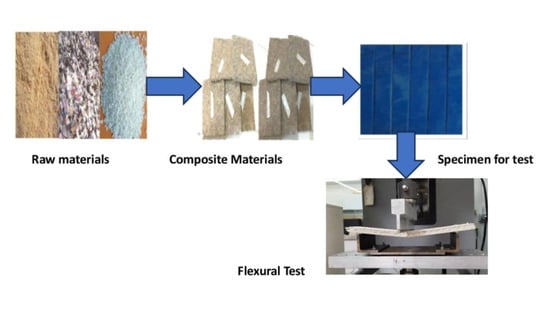Influence of Physical–Mechanical Strength and Water Absorption Capacity on Sawdust–Waste Paper–Recycled Plastic Hybrid Composite for Ceiling Tile Application
Abstract
:1. Introduction
2. Materials and Methods
2.1. Collection of Materials
Preparation of Composites
2.2. Composite Mix Design
2.3. Physical Tests
2.4. Water Absorption Tests
Thickness Swelling Test
2.5. Mechanical Test
2.5.1. Flexural Test of the Composites
2.5.2. Measurement of Thermal Conductivity
3. Results and Discussion
3.1. Physical Properties
3.1.1. Measurement of Weight
3.1.2. WA
3.2. Thermal Conductivity
3.3. Mechanical Properties
FS
4. Conclusions
Author Contributions
Funding
Data Availability Statement
Conflicts of Interest
References
- Adedayo, S.; Abere, J.O. Manufacturing of Non-Asbestos Ceiling. Int. J. Innov. Sci. Technol. 2021, 8, 1–10. [Google Scholar]
- Ohijeagbon, I.O.; Adeleke, A.A.; Mustapha, V.T.; Olorunmaiye, J.A.; Okokpujie, I.P.; Ikubanni, P.P. Development and characterization of wood-polypropylene plastic-cement composite board. Case Stud. Constr. Mater. 2020, 13, e00365. [Google Scholar] [CrossRef]
- Elsheikh, A.H.; Panchal, H.; Shanmugan, S.; Muthuramalingam, T.; El-Kassas, A.M.; Ramesh, B. Recent progresses in wood-plastic composites: Pre-processing treatments, manufacturing techniques, recyclability and eco-friendly assessment. Clean. Eng. Technol. 2022, 8, 100450. [Google Scholar] [CrossRef]
- Yi, X.S. An Introduction to Composite Materials; Cambridge University Press: Cambridge, UK, 2017; Volume 1. [Google Scholar]
- Wnek, G. Polymers. In Encylcopedia of Biomaterials and Biomedical Engineering, 2nd ed.; Informa Healthcare: London, UK, 2008. [Google Scholar]
- Allaf, R.M.; Albarahmieh, E.; Futian, M. Preparation of sawdust-filled recycled-PET composites via solid-state compounding. Processes 2020, 8, 100. [Google Scholar] [CrossRef]
- Lima, D.C.; de Melo, R.R.; Pimenta, A.S.; Pedrosa, T.D.; de Souza, M.J.C.; de Souza, E.C. Physical–mechanical properties of wood panel composites produced with Qualea sp. sawdust and recycled polypropylene. Environ. Sci. Pollut. Res. 2020, 27, 4858–4865. [Google Scholar] [CrossRef] [PubMed]
- Sensogut, C.; Ozalp, M.; Yesil, H. The effect of borax pentahydrate addition to urea formaldehyde on the mechanical characteristics and free formaldehyde content of plywood. Int. J. Adhes. Adhes. 2009, 29, 589–592. [Google Scholar] [CrossRef]
- ASTM C373-18; Water Absorption Offloor Tiles. ASTM International: West Conshohocken, PA, USA, 2018; Volume 2, pp. 1–7.
- Geyer, R.; Jambeck, J.R.; Law, K.L. Production, use, and fate of all plastics ever made. Sci. Adv. 2017, 3, 25–29. [Google Scholar] [CrossRef]
- Ozalp, M. Study of the effect of adding the powder of waste PET bottles and borax pentahydrate to the urea formaldehyde adhesive applied on plywood. Eur. J. Wood Wood Prod. 2011, 69, 369–374. [Google Scholar] [CrossRef]
- Sinha, V.; Patel, M.R.; Patel, J.V. Pet waste management by chemical recycling: A review. J. Polym. Environ. 2010, 18, 8–25. [Google Scholar] [CrossRef]
- Pivnenko, K.; Eriksson, E.; Astrup, T.F. Waste paper for recycling: Overview and identification of potentially critical substances. Waste Manag. 2014, 45, 134–142. [Google Scholar] [CrossRef]
- Ejaz, M.F.; Riaz, M.R.; Azam, R.; Hameed, R.; Fatima, A.; Deifalla, A.F.; Mohamed, A.M. Physico-Mechanical Characterization of Gypsum-Agricultural Waste Composites for Developing Eco-Friendly False Ceiling Tiles. Sustainability 2022, 14, 9797. [Google Scholar] [CrossRef]
- Obam, S. Properties of saw-dust, paper and starch composite ceiling board. Am. J. Sci. Ind. Res. 2012, 3, 300–304. [Google Scholar] [CrossRef]
- Ezenwa, O.N.; Obika, E.N.; Azaka, O.A.; Nwadike, E.C. Effect of filler carbonization on agro-waste based ceiling board. Adv. Mech. Eng. 2021, 13, 1687814021994403. [Google Scholar] [CrossRef]
- Saleem, S.; Rafiq, A.; Yusaf, S. Investigating the glass ceiling phenomenon: An empirical study of glass ceiling’s effects on selection-promotion and female effectiveness. S. Asian J. Bus. Stud. 2017, 6, 297–313. [Google Scholar] [CrossRef]
- Applin, D.M.; Izawa, M.R.; Cloutis, E.A.; Gillis-Davis, J.J.; Pitman, K.M.; Roush, T.L.; Hendrix, A.R.; Lucey, P.G. Ultraviolet spectral reflectance of carbonaceous materials. Icarus 2018, 307, 40–82. [Google Scholar] [CrossRef]
- Olujide, K.A.; Anaele, E.O.; Okereke, G.K.; Omeje, H.O. Production of Ceiling Tile with High Density Polyethylene (HDPE) and Polyethylene Terephthalate (PET) Plastic Wastes as Main Ingredients. J. Eng. Appl. Sci. 2019, 15, 114–127. [Google Scholar] [CrossRef]
- Ezenwa, O.N.; Obika, E.N.; Umembamalu, C.; Nwoye, F.C. Development of ceiling board using breadfruit seed coat and recycled low density polyethylene. Heliyon 2019, 5, e02712. [Google Scholar] [CrossRef] [PubMed]
- Bui, H.; Sebaibi, N.; Boutouil, M.; Levacher, D. Determination and Review of Physical and Mechanical Properties of Raw and Treated Coc Materials. Fibers 2020, 8, 37. [Google Scholar] [CrossRef]
- Lertwattanaruk, P.; Suntijitto, A. Properties of natural fiber cement materials containing coconut coir and oil palm fibers for residential building applications. Constr. Build. Mater. 2015, 94, 664–669. [Google Scholar] [CrossRef]
- Teeraphantuvat, T.; Jatuwong, K.; Jinanukul, P.; Thamjaree, W.; Lumyong, S.; Aiduang, W. Improving the Physical and Mechanical Properties of Mycelium-Based Green Composites Using Paper Waste. Polymers 2024, 16, 262. [Google Scholar] [CrossRef]
- BS EN323; Wood-Based Panels—Determination of Density. BSI Group: London, UK, 1993.
- Dotun, A.O.; Adesoji, A.A.; Oluwatimilehin, A.C. Physical and mechanical properties evaluation of particle board produced from saw dust and plastic waste. Int. J. Eng. Res. Afr. 2018, 40, 1–8. [Google Scholar] [CrossRef]
- BS EN317; Particleboards and Fibreboards—Determination of Swelling in Thickness after Immersion in Water. BSI Group: London, UK, 1993.
- BS EN 310; Wood-Based Panels—Determination of Modulus of Elasticity in Bending and of Bending Strength. BSI Group: London, UK, 1993.
- Dessalegn, Y.; Singh, B.; Safayo, B.B.; Jameel, M.; Hossain, N.; Rashedi, A.; Ahmed, G.M.S. Ethiopian Bamboo Fiber Aging Process and Reinforcement: Advancing Mechanical Properties of Bamboo Fiber-Epoxy Composites for Automobile Applications. J. Compos. Sci. 2023, 7, 375. [Google Scholar] [CrossRef]
- ASTM-D790; Standard Test Methods for Flexural Properties of Unreinforced and Reinforced Plastics and Electrical Insulating Materials. ASTM: West Conshohocken, PA, USA, 2017.
- Zicherman, J.B.; Allard, D.L. Fire performance of fire-retardant wood fiberboard ceiling tile. Fire Mater. 1992, 16, 187–196. [Google Scholar] [CrossRef]
- ASTM-C518; Standard Test Method for Steady-State Thermal Transmission Properties by Means of the Heat Flow Meter Apparatus. ASTM: West Conshohocken, PA, USA, 2021.
- Liu, K.; Lu, L.; Wang, F.; Liang, W. Theoretical and experimental study on multi-phase model of thermal conductivity for fiber reinforced concrete. Constr. Build. Mater. 2017, 148, 465–475. [Google Scholar] [CrossRef]
- ANSI 208 Standard; Medium Density Fiberboard (MDF) for Interior Applications. Composite Panel Association: Gaithersburg, MD, USA, 2002.
- Amena, B.T.; Altenbach, H.; Tibba, G.S.; Hossain, N. Investigation of Mechanical Properties of Coffee Husk-HDPE-ABS Polymer Composite Using Injection-Molding Method. J. Compos. Sci. 2022, 6, 354. [Google Scholar] [CrossRef]
- Omar, M.F.; Abdullah, M.A.H.; Rashid, N.A.; Rani, A.L.A.; Illias, N.A. The Application of Coconut Fiber as Insulation Ceiling Board in Building Construction. IOP Conf. Ser. Mater. Sci. Eng. 2020, 864, 012196. [Google Scholar] [CrossRef]
- Ichetaonye, S.I.; Ajekwene, K.K.; Ulaeto, S.B.; Yibowei, M.E.; Alosaimi, A.M.; Hussein, M.A.; Khan, A. Sustainable Alternative Ceiling Boards Using Palm Kernel Shell (PKS) and Balanite Shell (BS). J. Polym. Environ. 2021, 29, 3878–3886. [Google Scholar] [CrossRef]
- Asdrubali, F.; D’Alessandro, F.; Schiavoni, S. A review of unconventional sustainable building insulation materials. Sustain. Mater. Technol. 2015, 4, 1–17. [Google Scholar] [CrossRef]
- Koay, S.C.; Subramanian, V.; Chan, M.Y.; Pang, M.M.; Tsai, Y.; Cheah, K.H. Preparation and Characterization of Wood Plastic Composite Made Up of Durian Husk Fiber and Recycled Polystyrene Foam. MATEC Web Conf. 2018, 152, 02019. [Google Scholar] [CrossRef]
- Folorunso, O.P.; Anyata, B.U. Potential use of waste paper/sludge as a ceiling board material. Adv. Mater. Res. 2007, 18–19, 49–53. [Google Scholar] [CrossRef]

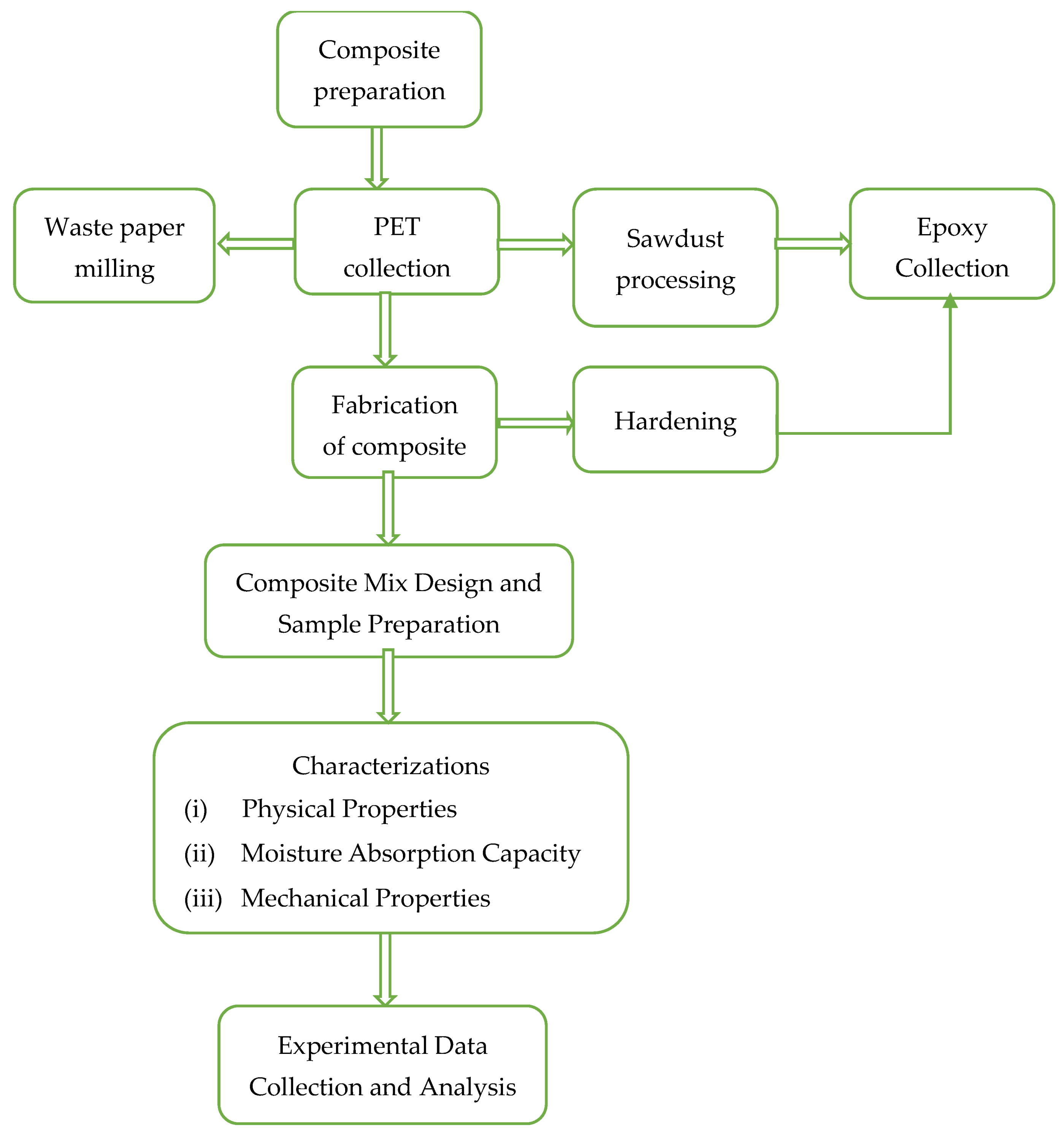



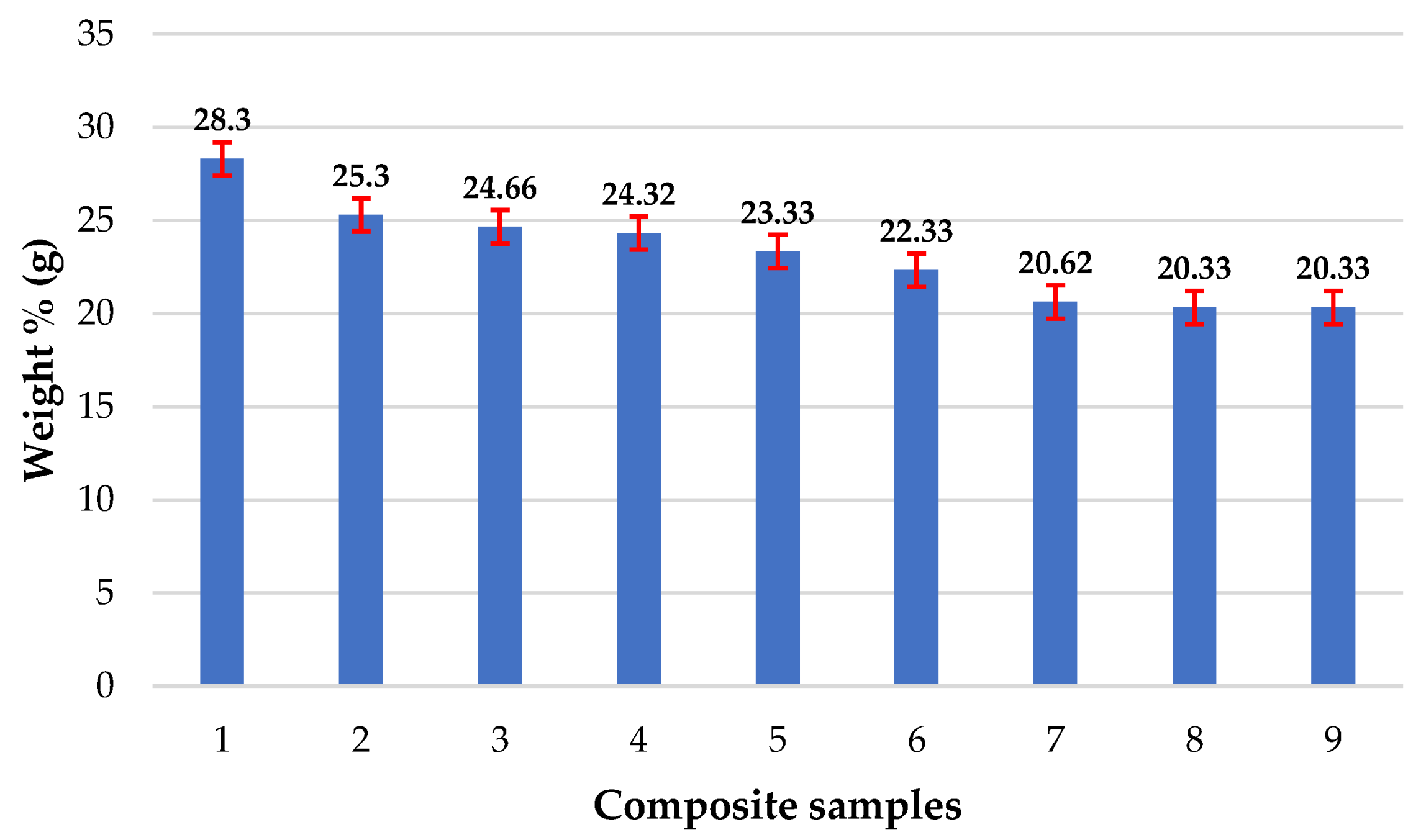


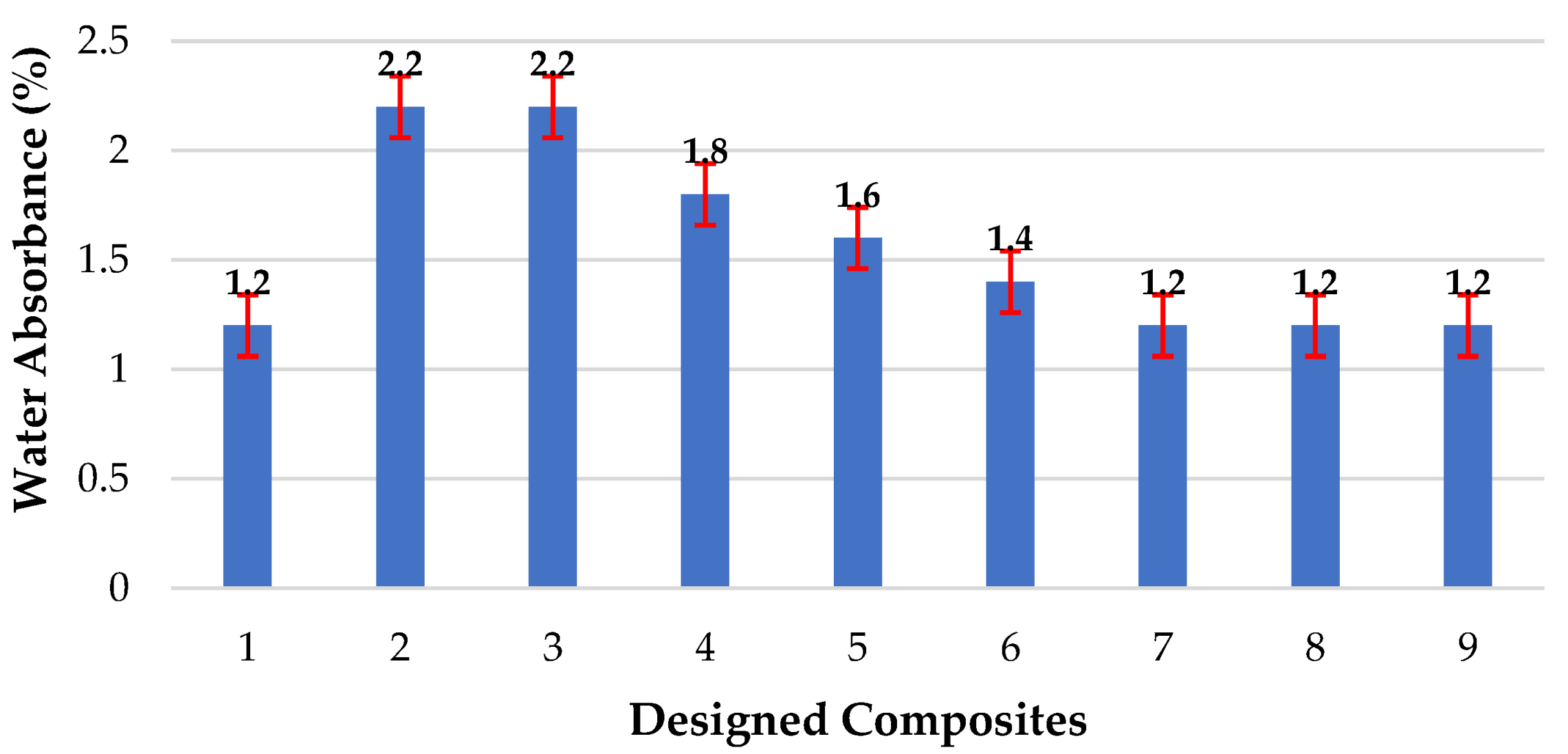


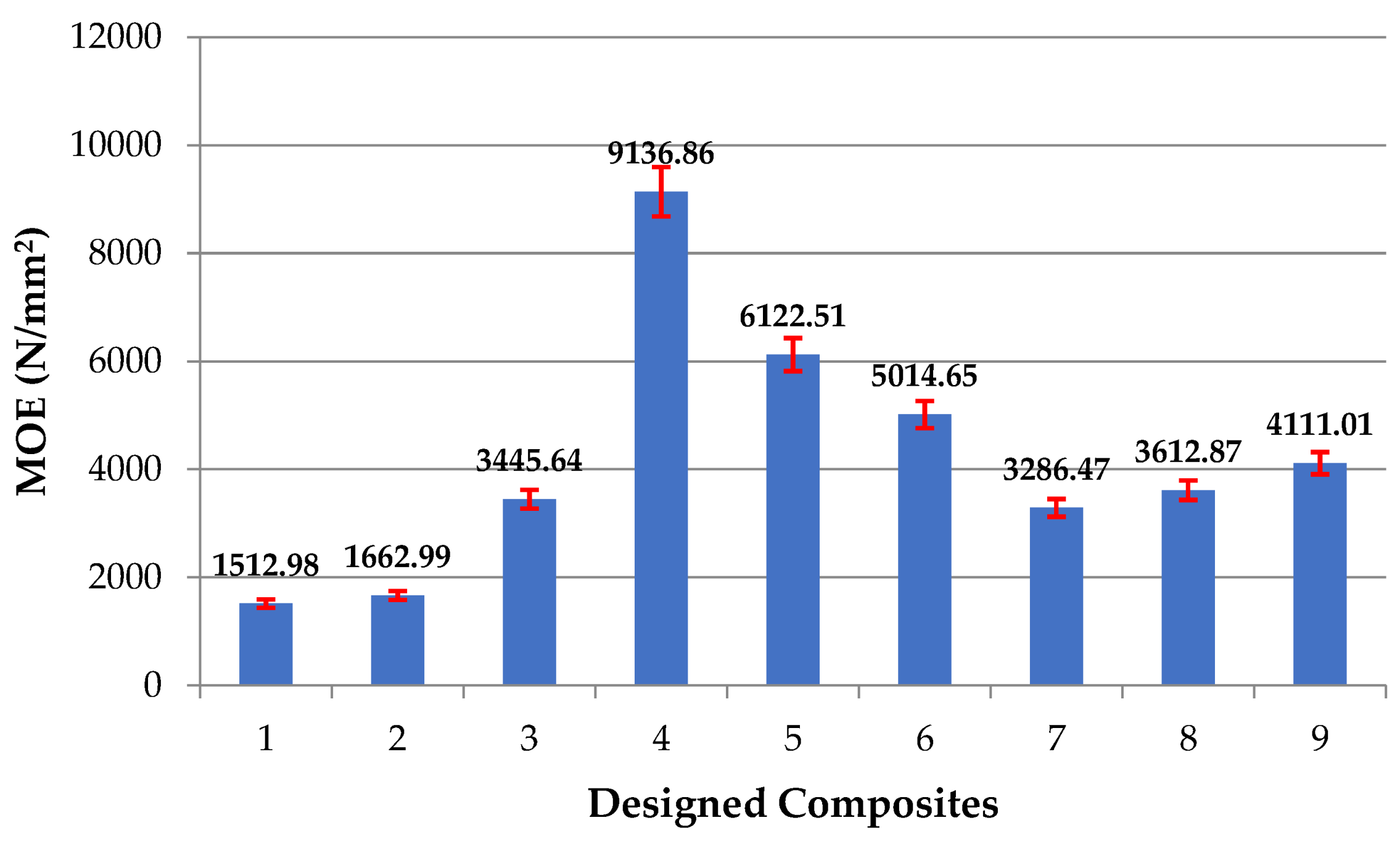
| Sample | % Sawdust | %Waste Paper | %Recycled PET | %Resin |
|---|---|---|---|---|
| 1 | 40 | 0 | 10 | 50 |
| 2 | 35 | 5 | 10 | 50 |
| 3 | 30 | 10 | 10 | 50 |
| 4 | 25 | 15 | 10 | 50 |
| 5 | 20 | 20 | 10 | 50 |
| 6 | 15 | 25 | 10 | 50 |
| 7 | 10 | 30 | 10 | 50 |
| 8 | 5 | 35 | 10 | 50 |
| 9 | 0 | 40 | 10 | 50 |
| S. N | Volume (m3) | Mass in (kg) | Density (kg/m3) | Relative Density |
|---|---|---|---|---|
| 1 | 13 × 10−4 | 0.0254 | 21.42 | 0.02642 |
| 2 | 13 × 10−4 | 0.0243 | 20.69 | 0.02432 |
| 3 | 13 × 10−4 | 0.0238 | 19.48 | 0.01932 |
| 4 | 13 × 10−4 | 0.0235 | 18.82 | 0.01826 |
| 5 | 13 × 10−4 | 0.0225 | 17.92 | 0.01726 |
| 6 | 13 × 10−4 | 0.0206 | 15.86 | 0.01651 |
| 7 | 13 × 10−4 | 0.0205 | 15.74 | 0.01654 |
| 8 | 13 × 10−4 | 0.0204 | 15.62 | 0.01632 |
| 9 | 13 × 10−4 | 0.0203 | 15.54 | 0.01622 |
| Sample Number | Average Temperature (°C) | Thermal Conductivity (W/m.K) |
|---|---|---|
| 1 | 32 | 9.7867 × 10−4 |
| 2 | 32 | 9.7867 × 10−4 |
| 3 | 32 | 9.7867 × 10−4 |
| 4 | 31 | 1.6770 × 10−3 |
| 5 | 31 | 1.6770 × 10−3 |
| 6 | 31 | 1.6770 × 10−3 |
| 7 | 31 | 1.6770 × 10−3 |
| 8 | 32 | 9.7867 × 10−4 |
| 9 | 32 | 9.7867 × 10−4 |
Disclaimer/Publisher’s Note: The statements, opinions and data contained in all publications are solely those of the individual author(s) and contributor(s) and not of MDPI and/or the editor(s). MDPI and/or the editor(s) disclaim responsibility for any injury to people or property resulting from any ideas, methods, instructions or products referred to in the content. |
© 2024 by the authors. Licensee MDPI, Basel, Switzerland. This article is an open access article distributed under the terms and conditions of the Creative Commons Attribution (CC BY) license (https://creativecommons.org/licenses/by/4.0/).
Share and Cite
Amena, B.T.; Hossain, N. Influence of Physical–Mechanical Strength and Water Absorption Capacity on Sawdust–Waste Paper–Recycled Plastic Hybrid Composite for Ceiling Tile Application. J. Compos. Sci. 2024, 8, 176. https://doi.org/10.3390/jcs8050176
Amena BT, Hossain N. Influence of Physical–Mechanical Strength and Water Absorption Capacity on Sawdust–Waste Paper–Recycled Plastic Hybrid Composite for Ceiling Tile Application. Journal of Composites Science. 2024; 8(5):176. https://doi.org/10.3390/jcs8050176
Chicago/Turabian StyleAmena, Berhanu Tolessa, and Nazia Hossain. 2024. "Influence of Physical–Mechanical Strength and Water Absorption Capacity on Sawdust–Waste Paper–Recycled Plastic Hybrid Composite for Ceiling Tile Application" Journal of Composites Science 8, no. 5: 176. https://doi.org/10.3390/jcs8050176






